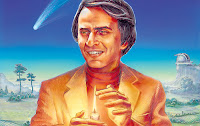
Envision if you will a voyage to the ends of the solar system aboard a spaceship that still exists within the realm of imagination. A spacecraft named Pegasus. It will embark on a six year voyage that will take an international crew of five astronauts to Venus, Mars, a harrowing close flyby of our nearest star- the Sun, and then on to the outer reaches of the Solar system to the Giant Planets Jupiter and Saturn and on to the dwarf planet Pluto. And, on the return journey home imagine a close encounter with that most ancient of relics of our solar system’s formation - a comet. This voyage is nothing less than a 21st Century grand tour of the awe inspiring wonders of our solar system. Accompany the intrepid crew of the spaceship Pegasus as they undertake take a Space Odyssey to the ends of the Solar System and beyond. The technology to commence such a voyage does not quite exist yet. But, perhaps it will one day.
The broadcast of Space Odyssey on the United States' The Science Channel differed from the full version with the cut of the arrival at Pluto and simply proceeded with the crew heading to the comet. This is because the U.S. version had the crew decide to turn back to Earth rather than press on to Pluto. The encounter with the comet is inferred to take place somewhere between Saturn and Jupiter. The British version with the astronauts going on to Pluto is more awe inspiring.
I think the show inadvertently undermined the role humans could play in future planetary exploration. Especially, when one sees missions to Venus and Io ending in near disaster.
The broadcast of Space Odyssey on the United States' The Science Channel differed from the full version with the cut of the arrival at Pluto and simply proceeded with the crew heading to the comet. This is because the U.S. version had the crew decide to turn back to Earth rather than press on to Pluto. The encounter with the comet is inferred to take place somewhere between Saturn and Jupiter. The British version with the astronauts going on to Pluto is more awe inspiring.
I think the show inadvertently undermined the role humans could play in future planetary exploration. Especially, when one sees missions to Venus and Io ending in near disaster.

The most devastating blow comes when John Pearson dies of solar radiation-induced cancer in Saturn orbit, the point where the crew must decide whether to continue the mission to Pluto, or abort and return to Earth. The crew decides to press on to Pluto, making history. There were just too many near disasters in one mission.
On the whole the special effects, planetary landscapes and music were very inspirational and set the heart stirring. The Pegasus spacecraft and landers were very plausible engineering marvels and created a highly realistic 21st century depiction of just how such a Grand Tour Odyssey could feasibly be undertaken. I highly recommend that you buy this series which is currently available on DVD home video.
Here are some video highlights of this fantastic documentary.
Space Odyssey Introduction
Space Odyssey: Venus Encounter Part 1
Space Odyssey: Venus Encounter Part 2
Space Odyssey: Mission to Mars Part 1
Space Odyssey: Mission To Mars Part 2
Space Odyssey Aerobraking at Jupiter
Space Odyssey Mission to Jupiter's Volcanic Moon Io






